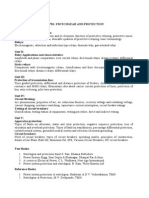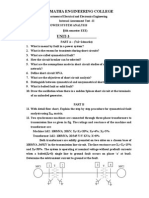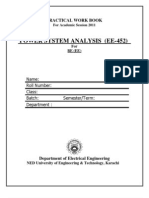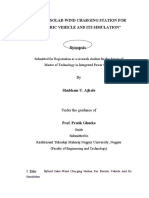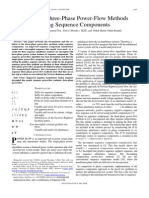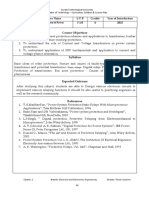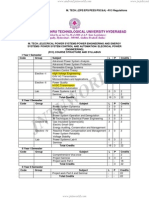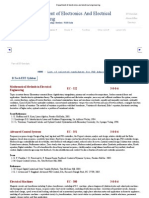0 ratings0% found this document useful (0 votes)
562 viewsAdvanced Power System Analysis r13
This document outlines the course units for an M.Tech course in power systems analysis. The 5 units cover:
1) Admittance and network calculations using YBUS matrices. 2) Impedance modeling and calculations using ZBUS matrices. 3) Power flow solution methods like Gauss-Seidel, NR, and decoupled. 4) Contingency analysis using ZBUS including single and multiple contingencies. 5) Fault analysis using ZBUS for symmetrical and unsymmetrical faults. Reference texts and books are also listed.
Uploaded by
aleem_201sCopyright
© © All Rights Reserved
Available Formats
Download as PDF, TXT or read online on Scribd
0 ratings0% found this document useful (0 votes)
562 viewsAdvanced Power System Analysis r13
This document outlines the course units for an M.Tech course in power systems analysis. The 5 units cover:
1) Admittance and network calculations using YBUS matrices. 2) Impedance modeling and calculations using ZBUS matrices. 3) Power flow solution methods like Gauss-Seidel, NR, and decoupled. 4) Contingency analysis using ZBUS including single and multiple contingencies. 5) Fault analysis using ZBUS for symmetrical and unsymmetrical faults. Reference texts and books are also listed.
Uploaded by
aleem_201sCopyright
© © All Rights Reserved
Available Formats
Download as PDF, TXT or read online on Scribd
You are on page 1/ 1
M. TECH.
(EPE/EPS/PEES/PSC&A) R13 Regulations
JAWAHARLAL NEHRU TECHNOLOGICAL UNIVERSITY HYDERABAD
M. TECH I YEAR I SEM. (EPE/EPS/PEES/PSC&A)
ADVANCED POWER SYSTEM ANALYSIS
UNIT-I:
Admittance Model and Network Calculations, Branch and Node Admittances, Mutually Coupled
Branches in YBUS , An Equivalent Admittance Network, Modification of YBUS , Network Incidence
Matrix and YBUS , Method of Successive Elimination, Node Elimination, Triangular Factorization,
Sparsity and Near Optimal Ordering.
UNIT-II:
Impedance Model and Network Calculations, the BUS Admittance and Impedance Matrices,
Thevenins
Theorem and ZBUS ,Algorithms for building ZBUS Modification of existing ZBUS,
Calculation of ZBUS elements from YBUS, Power Invariant Transformations, Mutually Coupled
Branches in ZBUS.
UNIT-III:
Gauss Seidel method, N-R Method, Decoupled method, fast decoupled method, comparison
between power flow solutions. DC load flow.
UNIT-IV:
ZBUS Method in Contingency Analysis, Adding and Removing Multiple Lines, Piecewise Solution
of Interconnected Systems, Analysis of Single Contingencies, Analysis of Multiple Contingencies,
Contingency Analysis of DC Model, System Reduction for Contingency and Fault Studies.
UNIT-V:
Fault Analysis: Symmetrical faults-Fault calculations using ZBUS- Fault calculations using ZBUS
equivalent circuits Selection of circuit breakers- Unsymmetrical faults-Problems on various types
of faults.
TEXT BOOK:
1. John J.Grainger and W.D. Stevenson, Power System Analysis - T.M.H.Edition.
REFERENCE:
1. Olle. L.Elgard, Electrical Energy Systems Theory-T.M.H.Edition.
2. Power systems stability and control, Prabha Kundur, The Mc Graw Hill companies.
3.
4. Power System Operation and Control, Dr. K. Uma Rao, Wiley India Pvt. Ltd.
5.
6. Operation and Control in Power Systems, PSR Murthy, Bs Publications.
7.
8. Power System Operation, Robert H. Miller, Jamesh H. Malinowski, The Mc Graw Hill
companies.
Power Systems Analysis, operation and control by Abhijit Chakrabarti, Sunitha Halder, PHI 3/e ,
2010
2. Modern Power System Analysis by I.J.Nagrath & D.P.Kothari Tata M Graw Hill Publishing
nd
Company Ltd, 2 edition.
REFERENCE BOOKS:
rd
1. Power System Analysis and Design by J.Duncan Glover and M.S.Sarma., cengage 3
Edition.
2. Electric Energy systems Theory by O.I.Elgerd, Tata Mc Graw-hill Publishing Company
Ltd., Second edition.
3. Power System Analysis by Grainger and Stevenson, Tata McGraw Hill.
4. Power System Analysis by C.L.Wadhwa, Newage International-3rd Edition
You might also like
- Power System Analysis Syallbus MG Univ KeralaNo ratings yetPower System Analysis Syallbus MG Univ Kerala1 page
- Analysis For Power System State EstimationNo ratings yetAnalysis For Power System State Estimation9 pages
- Visvesvaraya Technological University Belagavi: Scheme of Teaching and Examination and Syllabus100% (1)Visvesvaraya Technological University Belagavi: Scheme of Teaching and Examination and Syllabus55 pages
- IEEE 2012 Matlab Simulink Power Electronics Projects (Hosur, BanGalore, Mysore, ManGalore, Karnataka)No ratings yetIEEE 2012 Matlab Simulink Power Electronics Projects (Hosur, BanGalore, Mysore, ManGalore, Karnataka)16 pages
- Power Flow: EE 150 Power System Analysis 2No ratings yetPower Flow: EE 150 Power System Analysis 221 pages
- On A New Approach For The Simulation of Transients in Power SystemsNo ratings yetOn A New Approach For The Simulation of Transients in Power Systems6 pages
- Voltage Stability Toolbox For Power System Education and ResearchNo ratings yetVoltage Stability Toolbox For Power System Education and Research11 pages
- Useful Formulas For Power System AnalysisNo ratings yetUseful Formulas For Power System Analysis7 pages
- Rr410203-Computer Methods in Power Systems FinalNo ratings yetRr410203-Computer Methods in Power Systems Final8 pages
- Synopsis: "Hybrid Solar-Wind Charging Station For Electric Vehicle and Its Simulation"No ratings yetSynopsis: "Hybrid Solar-Wind Charging Station For Electric Vehicle and Its Simulation"9 pages
- ENGR 8-4 UNIT PLAN Fluid Power Syringe CraneNo ratings yetENGR 8-4 UNIT PLAN Fluid Power Syringe Crane12 pages
- A Three-Phase State Estimation in Active Distribution Networks PDFNo ratings yetA Three-Phase State Estimation in Active Distribution Networks PDF9 pages
- Dynamic Average-Value Modeling of CIGRE HVDC Benchmark SystemNo ratings yetDynamic Average-Value Modeling of CIGRE HVDC Benchmark System9 pages
- Improved Three-Phase Power-Flow Methods Using Sequence Components - MA Akher - KM Nor - AHA RashidNo ratings yetImproved Three-Phase Power-Flow Methods Using Sequence Components - MA Akher - KM Nor - AHA Rashid13 pages
- The Analysis of Lightning Overvoltage by Emtp For Lightning Protection Design of 500 KV Substation Noor Azila Binti Khazaimah TK3091.N66 2006No ratings yetThe Analysis of Lightning Overvoltage by Emtp For Lightning Protection Design of 500 KV Substation Noor Azila Binti Khazaimah TK3091.N66 20064 pages
- Syllabus-MTech-Digital Protection Power SystemNo ratings yetSyllabus-MTech-Digital Protection Power System3 pages
- Modelling and Simulation of Hybrid Wind Solar Energy System Using MPPTNo ratings yetModelling and Simulation of Hybrid Wind Solar Energy System Using MPPT5 pages
- Power System Deregulation - SVEC-19 - M.techNo ratings yetPower System Deregulation - SVEC-19 - M.tech2 pages
- Unit 01: Introduction To Smart Grid: (6 HRS)No ratings yetUnit 01: Introduction To Smart Grid: (6 HRS)3 pages
- Unit-I Transmission Line Parameters: Conductor MaterialsNo ratings yetUnit-I Transmission Line Parameters: Conductor Materials53 pages
- Lfa (Lightning Frequency Arrester) For Merge100% (1)Lfa (Lightning Frequency Arrester) For Merge36 pages
- Contents:: One-Line Diagram Components of Power SystemNo ratings yetContents:: One-Line Diagram Components of Power System13 pages
- Simulation of Some Power System, Control System and Power Electronics Case Studies Using Matlab and PowerWorld SimulatorFrom EverandSimulation of Some Power System, Control System and Power Electronics Case Studies Using Matlab and PowerWorld SimulatorNo ratings yet
- Power System Control and Automation Syllabus100% (1)Power System Control and Automation Syllabus23 pages
- Department of Electronics and Electrical EngineeringNo ratings yetDepartment of Electronics and Electrical Engineering3 pages


